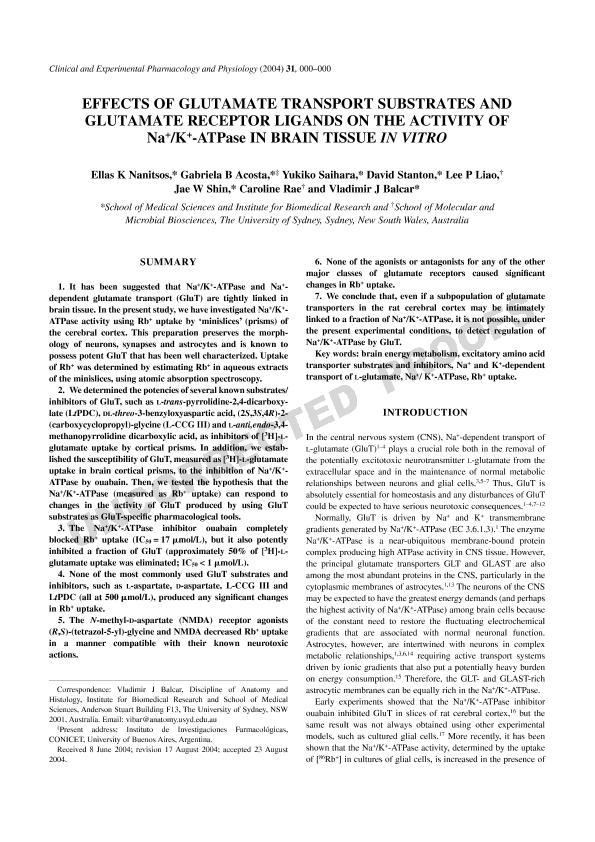Artículo
Effects of glutamate transport substrates and glutamate receptor ligands on the activity of Na+/K+-ATPase in brain tissue in vitro
Nanitsos, Ellas K.; Acosta, Gabriela Beatriz ; Saihara, Yukiko; Stanton, David; Liao, Lee P.; Shin, Jae W.; Rae, Caroline; Balcar, Vladimir J.
; Saihara, Yukiko; Stanton, David; Liao, Lee P.; Shin, Jae W.; Rae, Caroline; Balcar, Vladimir J.
 ; Saihara, Yukiko; Stanton, David; Liao, Lee P.; Shin, Jae W.; Rae, Caroline; Balcar, Vladimir J.
; Saihara, Yukiko; Stanton, David; Liao, Lee P.; Shin, Jae W.; Rae, Caroline; Balcar, Vladimir J.
Fecha de publicación:
11/2004
Editorial:
Wiley Blackwell Publishing, Inc
Revista:
Clinical and Experimental Pharmacology and Physiology
ISSN:
0305-1870
Idioma:
Inglés
Tipo de recurso:
Artículo publicado
Clasificación temática:
Resumen
1. It has been suggested that Na+/K+-ATPase and Na+-dependent glutamate transport (GluT) are tightly linked in brain tissue. In the present study, we have investigated Na+/K +-ATPase activity using Rb+ uptake by 'minislices' (prisms) of the cerebral cortex. This preparation preserves the morphology of neurons, synapses and astrocytes and is known to possess potent GluT that has been well characterized. Uptake of Rb+ was determined by estimating Rb+ in aqueous extracts of the minislices, using atomic absorption spectroscopy. 2. We determined the potencies of several known substrates/inhibitors of GluT, such as L-trans-pyrrolidine-2,4-dicarboxylate (LtPDC), DL-threo-3-benzyloxyaspartic acid, (2S,3S,4R)-2-(carboxycyclopropyl)- glycine (L-CCG III) and L-anti,endo-3,4-methanopyrrolidine dicarboxylic acid, as inhibitors of [3H]-L-glutamate uptake by cortical prisms. In addition, we established the susceptibility of GluT, measured as [ 3H]-L-glutamate uptake in brain cortical prisms, to the inhibition of Na+/K+-ATPase by ouabain. Then, we tested the hypothesis that the Na+/K+-ATPase (measured as Rb+ uptake) can respond to changes in the activity of GluT produced by using GluT substrates as GluT-specific pharmacological tools. 3. The Na+/K +-ATPase inhibitor ouabain completely blocked Rb+ uptake (IC50 = 17 μmol/L), but it also potently inhibited a fraction of GluT (approximately 50% of [3H]-L-glutamate uptake was eliminated; IC50 < 1 μmol/L). 4. None of the most commonly used GluT substrates and inhibitors, such as L-aspartate, D-aspartate, L-CCG III and LtPDC (all at 500 μmol/L), produced any significant changes in Rb+ uptake. 5. The N-methyl-D-aspartate (NMDA) receptor agonists (R,S)-(tetrazol-5-yl)-glycine and NMDA decreased Rb+ uptake in a manner compatible with their known neurotoxic actions. 6. None of the agonists or antagonists for any of the other major classes of glutamate receptors caused significant changes in Rb+ uptake. 7. We conclude that, even if a subpopulation of glutamate transporters in the rat cerebral cortex may be intimately linked to a fraction of Na+/K+-ATPase, it is not possible, under the present experimental conditions, to detect regulation of Na+/K+-ATPase by GluT.
Archivos asociados
Licencia
Identificadores
Colecciones
Articulos(ININFA)
Articulos de INST.DE INVEST.FARMACOLOGICAS (I)
Articulos de INST.DE INVEST.FARMACOLOGICAS (I)
Citación
Nanitsos, Ellas K.; Acosta, Gabriela Beatriz; Saihara, Yukiko; Stanton, David; Liao, Lee P.; et al.; Effects of glutamate transport substrates and glutamate receptor ligands on the activity of Na+/K+-ATPase in brain tissue in vitro; Wiley Blackwell Publishing, Inc; Clinical and Experimental Pharmacology and Physiology; 31; 11; 11-2004; 762-769
Compartir
Altmétricas



